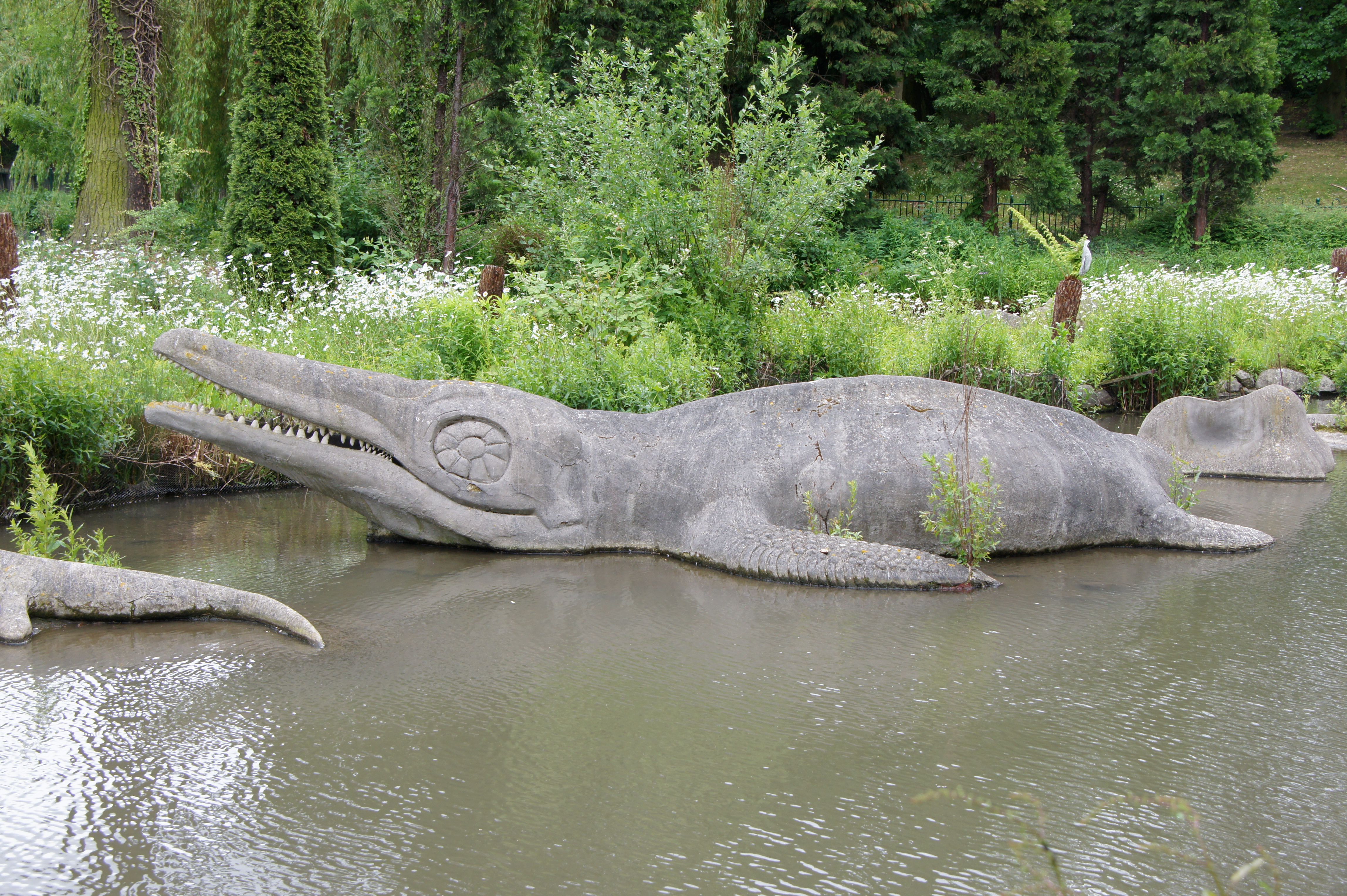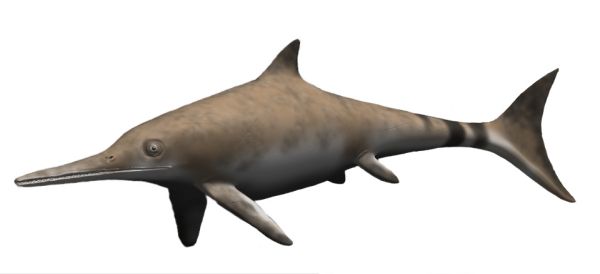|
Parvipelvia
Parvipelvia (Latin for "little pelvis" - ''parvus'' meaning "little" and ''pelvis'' meaning "pelvis") is an extinct clade of euichthyosaur ichthyosaurs that existed from the Late Triassic to the early Late Cretaceous (middle Norian to Cenomanian) of Asia, Australia, Europe, North America and South America. Named by Ryosuke Motani, in 1999, it contains the basal taxa like '' Macgowania'' and '' Hudsonelpidia''. Maisch and Matzke (2000) found in their analysis seven synapomorphies that support Parvipelvia. They also found 10 synapomorphies that support the existence of post-Triassic clade of ichthyosaurs (all parvipelvians excluding ''Macgowania'' and ''Hudsonelpidia''), for which the name Neoichthyosauria was found to be available. Parvipelvians were the only ichthyosaurs to survive the Triassic-Jurassic extinction event. Phylogeny Parvipelvia is a node-based taxon defined in 1999 as "the last common ancestor of ''Hudsonelpidia'', ''Macgowania'', ''Ichthyosaurus'' and al ... [...More Info...] [...Related Items...] OR: [Wikipedia] [Google] [Baidu] |
Ichthyosaur
Ichthyosaurs (Ancient Greek for "fish lizard" – and ) are large extinct marine reptiles. Ichthyosaurs belong to the order known as Ichthyosauria or Ichthyopterygia ('fish flippers' – a designation introduced by Sir Richard Owen in 1842, although the term is now used more for the parent clade of the Ichthyosauria). Ichthyosaurs thrived during much of the Mesozoic era; based on fossil evidence, they first appeared around 250 million years ago ( Ma) and at least one species survived until about 90 million years ago, into the Late Cretaceous. During the Early Triassic epoch, ichthyosaurs and other ichthyosauromorphs evolved from a group of unidentified land reptiles that returned to the sea, in a development similar to how the mammalian land-dwelling ancestors of modern-day dolphins and whales returned to the sea millions of years later, which they gradually came to resemble in a case of convergent evolution. Ichthyosaurs were particularly abundant in the Late Trias ... [...More Info...] [...Related Items...] OR: [Wikipedia] [Google] [Baidu] |
Temnodontosaurus Trigonodon
''Temnodontosaurus'' (Greek for "cutting-tooth lizard"temno, meaning "to cut", odont meaning "tooth" and sauros meaning "lizard") is an extinct genus of ichthyosaur from the Early Jurassic period. They lived between 200 and 175 million years ago (Hettangian-Toarcian) in what is now Western Europe, Western Europe (England, France, Luxembourg, Germany and Belgium) and possibly Chile. It lived in the deeper areas of the open ocean.Motani R.(2000). “Rulers of the Jurassic seas”. Scientific American. 283 (6): 52-59 University of Bristol paleontologist Jeremy Martin described the genus ''Temnodontosaurus'' as "one of the most ecologically disparate genera of ichthyosaurs," although the number of valid ''Temnodontosaurus'' species has varied over the years. ''Temnodontosaurus'' was one of the largest ichthyosaurs, with the type species (''T. platyodon'') reaching up to in maximum body length. It is known for its incredibly large eyes which, at approximately in diameter, are belie ... [...More Info...] [...Related Items...] OR: [Wikipedia] [Google] [Baidu] |
Temnodontosauridae
''Temnodontosaurus'' (Greek for "cutting-tooth lizard"temno, meaning "to cut", odont meaning "tooth" and sauros meaning "lizard") is an extinct genus of ichthyosaur from the Early Jurassic period. They lived between 200 and 175 million years ago ( Hettangian-Toarcian) in what is now Western Europe (England, France, Luxembourg, Germany and Belgium) and possibly Chile. It lived in the deeper areas of the open ocean.Motani R.(2000). “Rulers of the Jurassic seas”. Scientific American. 283 (6): 52-59 University of Bristol paleontologist Jeremy Martin described the genus ''Temnodontosaurus'' as "one of the most ecologically disparate genera of ichthyosaurs," although the number of valid ''Temnodontosaurus'' species has varied over the years. ''Temnodontosaurus'' was one of the largest ichthyosaurs, with the type species (''T. platyodon'') reaching up to in maximum body length. It is known for its incredibly large eyes which, at approximately in diameter, are believed to be the ... [...More Info...] [...Related Items...] OR: [Wikipedia] [Google] [Baidu] |
Suevoleviathanidae
''Suevoleviathan'' is an extinct genus of primitive ichthyosaur found in the Early Jurassic (Toarcian) of Holzmaden, Germany. Taxonomy The genus was named in 1998 by Michael Maisch for ''Leptopterygius disinteger'' and ''Ichthyosaurus integer'', both found in the Toarcian-age Posidonia Shale of Holzmaden.Maisch, W.A., 1998, A new ichthyosaur genus from the Posidonia Shale (Lower Toarcian, Jurassic) of Holzmaden, SW-Germany with comments on the phylogeny of post-Triassic ichthyosaurs. ''Neues Jahrbuch für Geologie und Paläontologie, Abhandlungen'', 209: 47–78 The generic name means " Swabian Leviathan". The type species is ''Leptopterygius disinteger'' Huene 1926. ''Ichthyosaurus integer'' Bronn 1844 was also reassigned to the genus by Maisch to create the new combination ''Suevoleviathan integer''. Based on the relocation of the holotype of ''Suevoleviathan integer'' and an updated description of the specimen, Maxwell (2018) concluded that the two ''Suevoleviathan'' spe ... [...More Info...] [...Related Items...] OR: [Wikipedia] [Google] [Baidu] |
Suevoleviathan
''Suevoleviathan'' is an extinct genus of primitive ichthyosaur found in the Early Jurassic (Toarcian) of Holzmaden, Germany. Taxonomy The genus was named in 1998 by Michael Maisch for ''Leptopterygius disinteger'' and ''Ichthyosaurus integer'', both found in the Toarcian-age Posidonia Shale of Holzmaden.Maisch, W.A., 1998, A new ichthyosaur genus from the Posidonia Shale (Lower Toarcian, Jurassic) of Holzmaden, SW-Germany with comments on the phylogeny of post-Triassic ichthyosaurs. ''Neues Jahrbuch für Geologie und Paläontologie, Abhandlungen'', 209: 47–78 The generic name means " Swabian Leviathan". The type species is ''Leptopterygius disinteger'' Huene 1926. ''Ichthyosaurus integer'' Bronn 1844 was also reassigned to the genus by Maisch to create the new combination ''Suevoleviathan integer''. Based on the relocation of the holotype of ''Suevoleviathan integer'' and an updated description of the specimen, Maxwell (2018) concluded that the two ''Suevoleviathan'' spe ... [...More Info...] [...Related Items...] OR: [Wikipedia] [Google] [Baidu] |
Macgowaniidae
''Macgowania'' is an extinct genus of parvipelvian ichthyosaur known from British Columbia of Canada. History of research ''Macgowania'' is known only from the holotype ROM 41992 ( RBCM EH 91.2.5), a partial skeleton which preserved nearly complete skull, almost complete forefin and other postcranial elements. It was collected in the Jewitt Spur locality from the Pardonet Formation, dating to the middle Norian stage of the Late Triassic, about 210 million years ago. It was found on the northern shore of the Peace Reach branch of Williston Lake. A second specimen from the same locality, ROM 41991, may be referable to this genus based on its forefin structure, but this cannot be confirmed due to its poor preservation. ''Macgowania'' has a very stable position in many cladistic analyses. The family Macgowaniidae was named by McGowan and Motani in 2003 to include this genus.McGowan C, Motani R. 2003. Ichthyopterygia. – In: Sues, H.-D. (ed.): ''Handbook of ... [...More Info...] [...Related Items...] OR: [Wikipedia] [Google] [Baidu] |
Hauffiopteryx
''Hauffiopteryx'' is an extinct genus of ichthyosaur known from Germany, Luxembourg and Somerset of the United Kingdom. Two species are known: ''H. typicus'' and ''H. altera''. History of study ''Hauffiopteryx'' was first described by Michael W. Maisch on the basis of some specimens that previously referred to '' Stenopterygius hauffianus''. Maisch found that the lectotype of ''S. hauffianus'' can be determined as ''Stenopterygius cf. S. quadriscissus'' at best, and therefore this species should be considered a nomen dubium. He also found out that most specimens previously referred to ''S. hauffianus'' can be referred to ''S. quadriscissus'', while the rest belongs to a highly distinctive new taxon that can't be referred to any valid species of ''Stenopterygius''. ''Hauffiopteryx'' is known from the lectotype GPIT 1491/4, articulated complete skeleton which preserved the skull and some soft tissues. The animal is about in length. It was collected from the ''Harpocera ... [...More Info...] [...Related Items...] OR: [Wikipedia] [Google] [Baidu] |
Hudsonelpidiidae
''Hudsonelpidia'' is an extinct genus of small parvipelvian ichthyosaur known from British Columbia of Canada. Description ''Hudsonelpidia'' is known only from the holotype, a nearly complete skeleton measuring less than long. It was collected in the Jewitt Spur locality from the Pardonet Formation, dating to the middle Norian stage of the Late Triassic, about 210 million years ago. It was found on the northern shore of the Peace Reach branch of Williston Lake. ''Hudsonelpidia'' has a very stable position in many cladistic analyses. The family Hudsonelpidiidae was named by McGowan and Motani in 2003 to include this genus.McGowan C, Motani R. 2003. Ichthyopterygia. – In: Sues, H.-D. (ed.): ''Handbook of Paleoherpetology, Part 8, Verlag Dr. Friedrich Pfeil'', 175 pp., 101 figs., 19 plts; München Taxonomy ''Hudsonelpidia'' was named by Chris McGowan in 1995 and the type species In zoological nomenclature, a type species (''species typica'') is the species name with whic ... [...More Info...] [...Related Items...] OR: [Wikipedia] [Google] [Baidu] |
Leptonectidae
Leptonectidae is a family of ichthyosaurs Ichthyosaurs (Ancient Greek for "fish lizard" – and ) are large extinct marine reptiles. Ichthyosaurs belong to the order known as Ichthyosauria or Ichthyopterygia ('fish flippers' – a designation introduced by Sir Richard Owen in 1842, alt ... known from Late Triassic to Early Jurassic marine deposits in Europe. They were all small to medium-sized creatures, most noted for their very long, swordfish-like snouts, which could have been used like a weapon, slashing through schools of fish.McGowan and Motani, 2003. Handbook of Paleoherpetology: Ichthyopterygia, Part 8. 175 pp. References Late Triassic ichthyosaurs Late Triassic first appearances Early Jurassic extinctions Prehistoric reptile families {{ichthyosaur-stub ... [...More Info...] [...Related Items...] OR: [Wikipedia] [Google] [Baidu] |
Thunnosauria
Thunnosauria (Greek for "tuna lizard" – ''thunnos'' meaning "tuna" and ''sauros'' meaning "lizard") is an extinct clade of parvipelvian ichthyosaurs from the Early Jurassic to the early Late Cretaceous ( Hettangian– Cenomanian) of Asia, Australia, Europe, North America, and South America. Named by Ryosuke Motani in 1999, it contains the basal taxa ''Ichthyosaurus'' and '' Stenopterygius'' and the family Ophthalmosauridae. In thunnosaurs, the fore fin is at least twice as long as the hind fin. Phylogeny Thunnosauria is a node-based taxon defined in 1999 as "the last common ancestor of '' Ichthyosaurus communis'' and ''Stenopterygius quadriscissus'' and all of its descendants". The cladogram A cladogram (from Greek ''clados'' "branch" and ''gramma'' "character") is a diagram used in cladistics to show relations among organisms. A cladogram is not, however, an evolutionary tree because it does not show how ancestors are related to ... below follows the topology fr ... [...More Info...] [...Related Items...] OR: [Wikipedia] [Google] [Baidu] |
Ophthalmosaurus Icenicus
''Ophthalmosaurus'' (meaning "eye lizard" in Greek) is an ichthyosaur of the Jurassic period (165–150 million years ago). Possible remains from the Cretaceous, around 145 million years ago, are also known. It was a relatively medium-sized ichthyosaur, measuring long and weighing . Named for its extremely large eyes, it had a jaw containing many small but robust teeth. Major fossil finds of this genus have been recorded in Europe with a second species possibly being found in North America. Description ''Ophthalmosaurus'' was a medium-sized ichthyosaur, measuring long and weighing . It had a robust, streamlined body that was nearly as wide as it was tall in frontal view. Like other derived ichthyosaurs ''Ophthalmosaurus'' had a powerful tail ending in a pronounced bi-lobed caudal fluke whose lower half was formed around the caudal spine whereas the upper lobe was made up entirely from soft tissue. The limbs of ''Ophthalmosaurus'' were short and rounded with the forelimbs bei ... [...More Info...] [...Related Items...] OR: [Wikipedia] [Google] [Baidu] |
Ichthyosaurus
''Ichthyosaurus'' (derived from Greek ' () meaning 'fish' and ' () meaning 'lizard') is a genus of ichthyosaurs from the Early Jurassic (Hettangian - Pliensbachian), with possible Late Triassic record, from Europe ( Belgium, England, Germany, Switzerland, and Portugal). It is among the best known ichthyosaur genera, as it is the type genus of the order Ichthyosauria.Maisch MW, Matzke AT. 2000. The Ichthyosauria. ''Stuttgarter Beiträge zur Naturkunde, Serie B (Geologie und Paläontologie)'' 298: 1-159McGowan C, Motani R. 2003. Ichthyopterygia. – In: Sues, H.-D. (ed.): ''Handbook of Paleoherpetology, Part 8, Verlag Dr. Friedrich Pfeil'', 175 pp., 101 figs., 19 plts; MünchenMaisch MW, Reisdorf AG, Schlatter R, Wetzel A. 2008. A large skull of Ichthyosaurus (Reptilia: Ichthyosauria) from the Lower Sinemurian (Lower Jurassic) of Frick (NW Switzerland). ''Swiss Journal of Geosciences'' 101: 617-627. History of discovery ''Ichthyosaurus'' was the first complete fossil to be disco ... [...More Info...] [...Related Items...] OR: [Wikipedia] [Google] [Baidu] |




